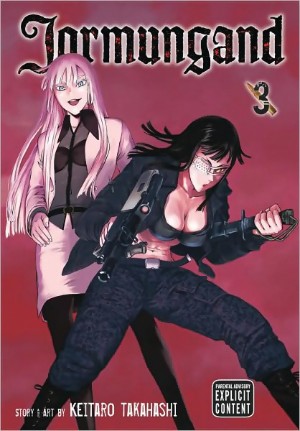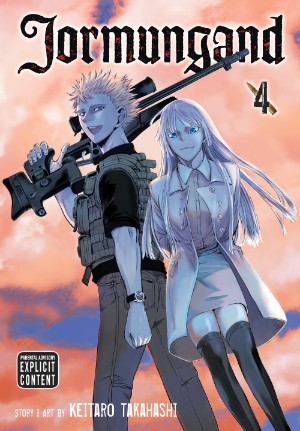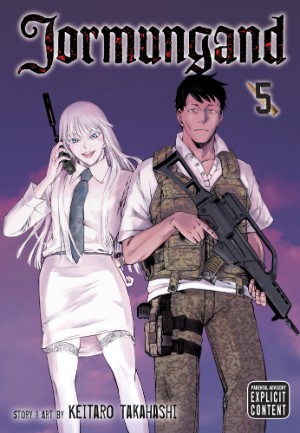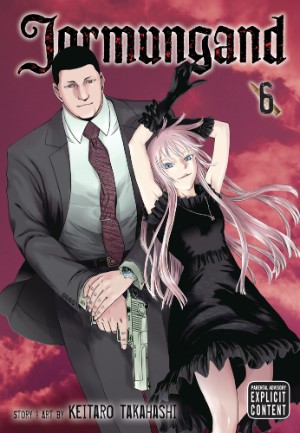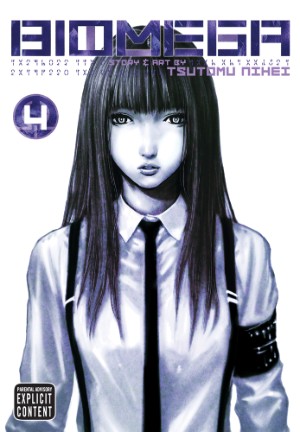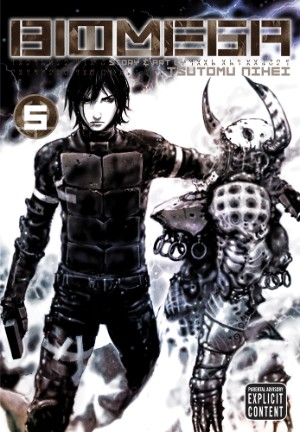
Logo handmade by Bannister
Column by Scott Green
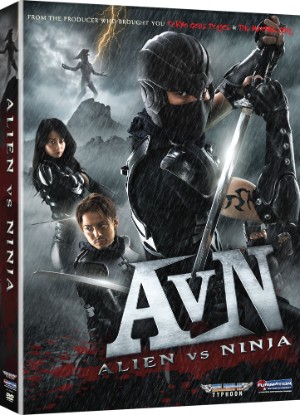
Live Action Spotlight: Alien vs Ninja
released by Funimation
Would something called Alien vs Ninja really be anything but a "does what it says what's on the tin" movie?
The fact that Alien vs Ninja puts its pitch in its title makes it plain enough that this Sushi Typhoon production is grasping for a death grip on simply understood, broad appeal. Coming out of the Machine Girl/Tokyo Gore Police school of get an umbrella 'cause it's going to be raining blood, the 80 minute movie does deliver on the promised arterial spray and viscera strewn affair pitting the shuriken throwing sort of men in black against a ravenous extra terrestrial. However, strange to say for a movie in which an acid bathed ninja tries to move his upper half after his lower parts are stripped to the bone, AVN doesn't impress with its gross out trangressivness.
Yet, Alien vs Ninja validates itself late in, after building up to the needed spirit of abandon. While it will take a lot to actually shock a media glutted audience, a film like this can amusingly raise some eyebrows. The school of movie making from which AVN comes is at its best when it can surprise the audience with what's been included in the production. Neither entirely in or out of line with reasonable expectations, when the final act finally manages this, it's not achieved by stomping on what the viewer would find acceptable. What works in its high points mostly is a function of goofing on conventions.
Alien versus Ninja is written and directed by Seiji Chiba, whose resume is dominated by the subject with works like Evil Ninja and Sengoku: Iga no ran on the list along with the script for Yûji Shimomura's (Versus) Death Trace. This one is set during Japan's pre-unification Sengoku Era, the heyday for samurai as battlefield combatants and a period in which ninja were employed in the raging warfare between domains. One of the most prominent clans of guerilla fighters turned convert operatives was the Iga. Here, a group of young Iga stumble into a Predator scenario. While reporting back to their elders after a mission, they see a fiery object fall from the sky. Assigned to investigate, the group is sent into harm’s way courtesy of a lethal xenomorph.
Shooting for the gleeful abandon, the subject squad of ninja are presented with wild anachronism. More than stylized, they're X-Men-ized in black, form fitting leather and latex, not to mention fashionably groomed facial hair and dye highlights. And, the personalities follow suit, with a couple of cool guys, a young woman who loves to get in and thrown down in the tussle and a pudgy asshole who has built a few problematic gadgets.
AVN does not make a good first impression. It looks cheap. My home town had a forested area on public land that grew up from trees planted by a Boy Scouts effort. The battle ground that these ninja tramp through has a similar let's-get-some-trees-here look. Early developments don't help much either. After talking through their last mission, the heroes return to their ninja village, where they are greeted by a pack of stupidly juvenile, effeminate bullies. Not effectively offensive and certainly not funny, the bit lands with a damaging thud, especially in that it undercuts the opportunity for a Dusk Til Dawn style genre swerve.
Even if the alien is the opponent on the title card, a ninja fan can't help but want to see some of the movie weave in the inter-ninja village warfare that it teases. Unfortunately, even if the dialog keeps on referring to the conflict, the comments are just drawing in the context.
A third of the way in, the xenomorph turns up and begins brutalizing the ninja. Let down by effects or choreography, the action rarely accomplishes its evident aim. While some of the ideas for ninja trading blows with the ET seem potentially exciting on paper, on screen, they fall flat. It's not just special effects that deflate the proceedings. It's elements as simple as a punch not looking credible. By the same token, the on screen viscera is never visceral enough (to get to a violence desensitized viewer).
The horrific bits don't turn out as well as the goofy ones, such as when the ninja play whack-a-mole with the alien spawn. Eventually, Alien vs Ninja sets up the right environment for its cheapness and lamess to ferment, after which, the movie finally turn intoxicating, Even then, a considerable amount of piling on needs to accumulate before it tips over with the requisite absurdity.
This school of movie making is at its most effective when the creators’ presence is felt. Violent blitzes that go one too long. Trangressions that go too far. Incongruities that are too out of sorts. When you start questioning what's on the screen, preferably with a group to share the bafflement, the brand of out of control movie is working.
Alien vs Ninja takes a while to get to the point of inebriation at which the forced wildness settles into the real thing... but still, better late than never. Especially with a group viewing value add factored in, there is a set of expectation that this movie can meet. And, the late craziness like an amusingly rubbery chambara showdown, are sufficiently demented that fans of movie oddities will have been glad to have caught Alien vs Ninja.

Manga Spotlight: Jormungand
by Keitaro Takahashi
Volumes 2-6
Released by Viz Media
Jormungand takes the renegade special operations team, aligns it with a more mature answer to the sort of spirited team of rule breakers found in manga like One Piece and sticks it on a current globalized, way past Cold War, War on Terror, China ascendant moment for a guns blazing action manga that has pronounced problems, but feels sufficiently sharp.
Jonah, a cold, brutally skilled ex-child soldier loathes violence and the industry built around it. Yet, when he's removed from the battle field, he still find himself in midst in conflict trade. Brilliant, unconventional arms dealer Koko Hekmatyar manages to add Jonah to her extraordinary cadre of bodyguards and field agents, comprised of former Finnish Rapid Deployment Force, Bersaglieri, Japanese Self Defense Force, Mafia and the like. Jonah finds the arms business complicated by Koko's group's adherence to their own code of ethics. They're willing to kill, and they are selling weapons, but they're also adamant in tossing out convention in favor of what they believe is right.
The various continent crossing ventures or battles generally span the course of five manga chapters, and the gambits more often than not feature plenty of manipulation along with the chases and fire fights.
Jonah and the rest of Koko's employees face off against various exotic strike teams, a roguish/borderline rogue CIA agent and his info broker partner, and a Chinese front company with similar interests and expertise. Koko is a scion of global commerce royalty and is subject to some sibling rivalry with her brother, waged in the shipping/arms business and probably devoting into the manga's overarching conflict.
And, the values, both mercenary and ethical, do play into the missions. While Koko and company race against rivals to lock down deals on munitions or drones, they also take contracts to smuggle Doctors Without Borders surrogates called “Outspoken Doctors for Human Rights” into a war zone while also dealing with the conflict's aggressors.
Keitaro Takahashi goes about Jormungand's business with messy verve, and the manga is both served and undercut by its imperfections.
In its handling of its characters and in its sentiments, the precise depth of Jormungand's ambitions is difficult to gauge. The manga opens with an author's note to the effect that "my first story is about arms dealers. It's a rather serious topic, but while I draw I'm always smiling and having a lot of fun." The follow-up is deadpan expression of concern about violence's real implications, and at the same time, even when confrontations are solve by outmaneuvering the adversary, the pay off for the reader is more often than not a muscular woman flinging herself into a knife fight or a dramatic shot from a sniper rifle.
Koko's team is comprised of people with families, adult-ish relationships or other mature-ish views of the world, and yet, they have a not-quite G.I Joe colorfulness to them. And, that pales next to some of the people/group with which they butt heads, as the manga offers an urban foot chase/fire fight with a girl (as in she's young, not as in calling a grown woman "girl") in a cowboy hat with Daredevil sense who refuses to wear underwear, and another young female opposing strike team member who wears a necklace of razor blades as she hops around with a bayonet affixed shot gun, teamed with an executioner hooded hulk who attacks Koko's operatives with a bolt cutter.
That sort of half cocked willingness to lay on some nonsense is one of the instance in which the approach serves the manga. The type of action in which Jormungand trades is not easily conveyed in manga/comics. No matter how many speed lines are etched in a panel, sudden shifts of velocity needed to convey impactful high speed chases and gun battles is rarely effectively worked in sequential art. The measured success of work arounds, focusing on set up and consequence, attitudes or short hand often invites thoughts of how neat the action would be if adapted into a full motion medium.
Akihiro Ito's Geobreeders is an unexceptional boring guy with exotic girls action series, made exceptional because, better than just about anyone else (I'd include Gunsmith Cat's Kenichi Sonada), Ito can pull off a automotive stunt in manga and give it near cinematic impact. That I remember this otherwise not to good manga, released by now defunct publisher Central Park Media six year ago speaks to how rarely this type of action is really well project into manga.
No Ito level talent, Keitaro Takahashi conveys action with a lot of close ups and instants. The steering wheel getting spun, the gas pedal being slammed down, the cars screeching around. These shots are never too removed from a characters face, with their expression, whether cold or battle rage fired, directing the reader's response. This doesn't wow with complexly laid out sequences, and there isn't too much give and take to tussles, but steering the vibrant characters with bold strokes this way does prove effective.
Jormungand doesn't fracture realism too far beyond what a Bourne movie would. In the scheme of manga, we're not talking the abandon of Crying Freeman's submarine knife fights, and Jormungand does try for a notable air of somewhat straight credibility. Beyond that degree of measuredness, as it flails its limbs, part of what helps the manga maintain a foot planted on the ground its attention to details. There's probably an audience of scrutiny prone military geeks reading this manga in its Japanese publication, and Jormungand does apparently have the aim of meeting their expectations. The way that the characters wrap their guns in white tape before trekking onto a snow covered field or even how they fill out their clothes with credibly muscled bodies lends the manga a sense that it's at least trying to conform to reality.
At the same time, the realishness and the attempts to nail the gun powered and burnt rubber tinged action are complemented by the manga always, unmistakably being Jormungand. Wonky lines, zip tones outside the area their supposed to shade. It's not so much ugly as it is purposefully haphazard. The disorder can't be entirely unintentional. Characters are always winking, stretching or moving at tangents, enhancing their asymmetry. This style makes Jormungand specific, bold, highlighted. It gives the manga its snarl. It's not just run and gun, it's run and gun with a distinct species of fanged people, adapted to thrive in orchestrated chaos.
If Jormungand is indulging in the spectacle of battle, and the manga certainly is, that should undercut, or at least complicate, the manga's suggestion that it is offering a serious meditation on subjects like the arms business or global conflict.
Whether Jormungand is being hypocritical or unsuccessful, the manga is not convincingly offering much of a worked out consideration of violence's appeal to the reader, the real consequence of violence or the possible relationship between the two. To its credit, Jormungand isn't lecturing or chiding the audience reading for the guns and gunfire. However, as it shoots from the hip, if it's trying to subvert their expectations, it isn't too smartly.
After that message from the author, Jonah introduces the manga, and he stands as its quiet conscious/soulful judge. Yet, it's no mistake that each of the book's covers feature Koko paired with a member of her crew. Her oddly shaped thinking and oddly shaped ethics are the primary molds for shaping the manga. Its stories are mostly structured around her manic thinking and often lateral solutions to the challenges of the arms business. Those other figures on the covers go off on their own directions, but, those directions are always set in an orbit pulled by the cult of personality around Koko.
While there is continuity in Jormungand, with returning adversaries and semi-adversaries or unfinished business being later resolved, there's little apparent focus on the long term or gathering momentum. Instead, Jormungand looks to find substance in those five chapter stories and in those characters revolving around Koko. When it comes time for the manga to prove its thoughtfulness, it offers familiar tracks of redemption and the ironic circles of revenge. Disappointingly, the ragingly free thinking crew aren't given the opportunity to overthrow the conventions. Even with Koko's circuitous plans in the mix, Jormungand never manages to demolish the genre enough to crack open a jagged look at the implications.
I'm not convinced that Jormungand would be better if it were stripped of the pretence, but I am convinced that it is not as provocative as it might have been if it would more able to work in more thoughtful moral and political considerations. As it stands, it's a nicely weirdly looking, nicely exotically populated modern action serial: enjoyable, particular, but, by the expectations it sets out, underachieving .
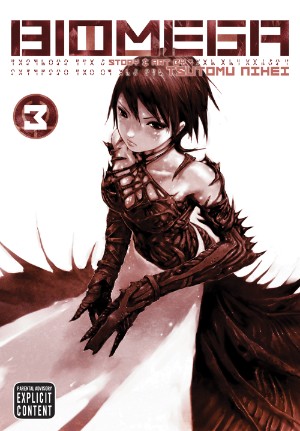
Manga Spotlight: Biomega
by Tsutomu Nihei
Volumes 3-5
Released by Viz Media
Sales figures suggest that there are people whose manga purchases are largely limited to the best sellers... the fans of Naruto and the like. Beyond that, observationally, manga appears to be largely bought by manga fans.
As someone who'd like to think that they possess an understanding of what media people would like, I believe that the reason for this is not so much that manga lacks broader appeal as it is that manga's a loser in the battle for the attention and funds of the potentially interested. After being looked or ruled out in dollar-to-entertainment calculation, there are plenty of audience that manga could speak to or entertain who give the medium little considerations.
Biomega is held up, both by critics and its publisher, as an example of manga that could appeal to consumers who generally direct their allotted entertainment resources towards video games.
Speaking of allotting time, I read plenty of video game reviews and listen to plenty of podcasts dedicated to the subject, but, honestly, I spend very little of my time actually playing video games. I do believe that I follow the industry and conversations about that medium to the extent that I have some understanding of what gamer look for and how games appeal for their attention, but I imagine that there's plenty of room for my opinions to be contradicted.
I both agree and disagree that Biomega deserves to be a paramount manga recommendation to gamers.
The position is far from baseless. Biomega author Tsutomu Nihei focuses on a sort of biomechnical horror sensibility that has long complemented video game shooters. It's little surprise that he was the manga creator tapped to produce a Halo comic for Marvel. Biomega features a lone, armed motorcyclist sent alone (apart from female, holographic AI) into a space-zombie infected plague-zone, in which he fights creepily apron clad, boned head hulks and the like. And, the icing on that cake is a consciousness in the body of bear, armed with sniper rifle who acquires a hook-hand.
At issue, for better and worse, Biomega is a Nihei work through and through - with all the double edged qualities along for that ride.
If you aim find manga in which you can open a book to any arbitrary page and be certain to find something to give an action sci-fi junkie a strait hit, you can't beat Biomega. Nihei's gift is his mastery of creating landscapes of cyclopean structures that truly appear to dwarf human beings, populating them with disconcertingly mutated inhabitants, and then sending lone, armed anti-heroes down the immensity. Disembarking with all the gear into landscapes that embody the definition of “alien”, Nihei reconfigures elements common to a popular genre of video games into a form that takes full advantage of the freedom afforded by manga. In practice, you couldn’t ask for a more spectacular manga based on a guy with a gun.
The work is reminiscent of plenty... both inspirations and of works that probably or definitely didn't inform Nihei's writing, but which Biomega still calls to mind. My first impression of the series was "Terminator/Kamen Rider enters a cyber-Lovecraftian zombie haunted town." (Checking the back of the book so as to avoiding revealing more that cover states) 'In a bid to remake the planet according to her design, Niarudi—Matriarch of the DRF (Data Recovery Foundation) —has unleashed the Reverse Morphic Polymer. This substance triggers a radical transformation of the Earth, preparing it for “restoration.” ' This enables Nihei to not just build out the biomechanical horror haunted cities of the manga’s early chapters, but to really inflate his imaginative vision to vast, sci-fi scales. As things get reconfigured, and not just a cityscape or domed Mars colony, but Strar Trek sized objects turned more alien, the backdrop begin looking like am astronomical scale version of the fungal forrests of Miyazaki's Nausicca. At the same time, as the synthetic, megacorp operative hero progresses into the madness, if there was stream of Lovecraft work that I'd compare the spiraling odyssey to, it'd be the trek into more fractured landscapes of his Dream Cycle.
The trouble is that Biomega is too free. In that, the unbound story becomes a bad read. It’s not just a weak story serving as barely sufficient tendons, holding together thundering visual booms. The narrative is actively problematic.
Freedom from emotion initially seemed to benefit the manga. Here was a cold juggernaut storming the halls of terror. The demeanor of the protagonist was so at odds with the world swallowing threat, that it was if this hero was settings his sights on the very concepts of disease and corruption. Since Biomega is based around this, the problem became, not so much that the manga was underwritten as lacking. It became a matter of an immovable object versus an unstoppable force, both of which are, after a fashion, showy. Neither of which has much personality. The spectacle persists, but there’s nothing to lack onto.
Beyond an appreciation for Biomega consistently looking exceptionally cool, it is difficult to muster much enthusiasm for what the armed mannequin is doing in his battle against all sorts of horrors. The blow by blow bits are comprehendible, but a larger sense of what he’s doing is illusive. It doesn’t feel like he’s driving events. For that matter, it doesn’t feel like his adversaries are either. After reading volume 5, I had no idea that the series was about to wrap up in its sixth.
More than conforming to some narrative structure, Biomega moves like it is subject to where Nihei’s thoughts wanders. It’s imaginative stuff, but imaginative in a way that suggests what must be floating around the head of the kid sitting in the back of a classroom, staring off into the middle distance. There is an expectation of at least an illusion of agency from modern video game. Biomega’s lack is an issue in the manga series and would be in a game as well.
If you’ve seen Final Fantasy: Advent Children, Biomega is like that, but more so... visually resounding, in theory attractive to gamers, but lacking the character or narrative hooks to really engender enthusiasm. Biomega is an attractive object with a surface that’s too polished. Applying words like “smooth” or “polished” to Biomega is out of sorts with a manga series defined by its broken, cancerous landscape, but that’s the issue here. Anything that might allow the manga to be really grasped on to has been blasted off.
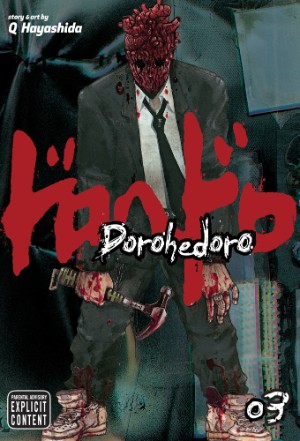
Manga Spotlight: Dorohedoro
by Q Hayashida
Volume 3
Apropos in a week where an escaped cobra garnered all sorts of news coverage, I have to say, there’s something fascinating about reptiles. Particularly large ones. Not fascinating in the way a cerebral conversation is fascinating. Fascinating in a way that fire or predatory animals are fascinating. Beyond being strikingly ugly, maybe so ugly that it finds beautiful on the back side, there's something evolutionary that causes the brain to lock in, saying “pay attention here.”
I wouldn’t call Dorohedoro the least antiseptic manga out there, given the range from gruesomely sexual/sexually gruesome ero-guro to the “good bad” scrawls of heta-uma, but it is a particularly scaly, prickly take on a revenge story, and that’s quite the starting point constructing a nest of impact laden spectacles. Bolstered by a delight in its own blood and cockroaches grunginess, it’s exactly the kind of manga to jar a reader out of a bored rut. If you feel manga is too much the same, or media in general is... if you put a premium on novelty and verve, Dorohedoro is not to be missed.
"The Hole" serves as the setting for a glib, fractured take on a brutal revenge story, reminiscent of a boil spotted descendant of Tarantino, Park Chan-wook, and their antecedents. The place a slum hunting/dumping ground for the human subjects of Sorcerers' experimentation. One of these guinea pigs has at least the will and ability to claw out some recompense. Caiman turned up in the Hole with a reptilian face, a case of amnesia and a raging lust for vengeance. He also proves to be immune to the Sorcerers' magic. Not a unique special ability in fantasy, but at least Dorohedoro doesn't tease out the revelation. Allied with a young woman named Nikaido, the proprietor of a dive eatery known as the Hungry Bug, Caiman applies a ferocity that might make Jack Bauer blanche to hunting down the identity of the Sorcerer who cursed him with lizard features.
Volume three finds Caiman and Nikaido jumping the gates into enemy territory... the Sorcerers' World. Given that that's a wonderland whose inhabitants are masked, and given to throwing themselves rotting corpse decorated dinner parties, the trouble with Caiman's invasion is not so much avoiding detection as it is maintaining bearings amidst the corked bottle shaped buildings, falling magic carpets and dungeon crawl from hell tunnels.
There is an apparent conspiracy at work here, and, supporting that, clues are peppered over Dorohedoro. Mysteries are evidently going to be revealed about Caimon, Nikaido and the cadre of Sorcerers with which the heroes lock horns. I don’t expected this to be dull and yet, the series is clearly not rigorously plotted. Q Hayashida has said as much. “I hadn't mapped anything out ahead of time. I just drew chapter by chapter. About the time IKKI became monthly, I decided roughly how it would end, and then each time drew whatever I wanted to draw most toward that ending.”
One event doesn't logically cascade off the last in a way that fosters consideration of what may happen next. While there is an overarching story, the driving force is less advancing that plot than it is by the author's imagination and design.
Relevant to the Biomega discussion, Q. Hayashida was an assistant to Tsutomu Nihei. On her own, did an actual video game adaption... tied to forgotten Dreamcast cyber-sci-fi brainjacking "first-person slasher" Maken X. Yet, unlike Nihei's work, Dorohedoro does not call to be compared to video games, favorably or unfavorably.
Biomega’s merits are evident at a glance. That’s a great selling point, and since that manga is comprised of a chain of those at a glance great moments, it’s an attractive packing. And yet, sitting down to read Biomega does the manga few favors.
In contrast, Dorohedoro is in no way lacking for handles. The series is still going after 15 volumes, so, maybe, it develops a plot that does matters. Currently, that’s just it, the plot is not essential to the appreciation of a series in which the pleasure is just reading and enjoying it one moment at a time. It’s sufficiently eventful and a sufficient amount of charisma is projected through the characters, and the cement is less plot based than it is how well the two complement each other. Though Caiman’s circumstances are mysterious, and though his adversaries share his/Nikaido’s tendency to trip into the mire, the trouble never seems to be materializing out of the ether. Acting with warped expressions of understandable behavior, these folks do do enough shit stirring that they seem to be bringing craziness into the world and are not just subject to it.
At the same time, rather than being dreamy, there's a discernible, magnetic authorial voice. There's a behind the scene grin as it paints mustaches on, or, more precisely, throws gimp masks over, conventions. Moe in particular gets a gleeful brow beating.
I’ve tried to establish the concept of “book shelf manga” - the enduring literature transcends trends and quick entertainment; the ones that you’ll want to have around a decent or more down the line. Tezuka’s Phoenix, his Ode to Kirihito and the like. Town of Evening Calm. Miyazaki’s Nausicaa.
Then there’s manga that endures in a different way... the ones that fill up the pop culture bank. That elicit off hand remarks and comparisons. Initially an “oh, shit, I just read a manga where...” and later “oh yeah, that's the manga where...”
I have to think for a moment to picture something particular cool from Ruruoni Kenshin. Battle Angel Alita is a favorite, but I remember what I felt or thought about it more than any precise sequence.
Alternatively... Fist of the North Star: that's the one’s where Kenshiro kicks the obese Heart in the Gut until a strike gets to the nerve center. Jojo’s Bizarre Adventure: that’s the one where Dio knives Jotaro then drops a steam roller on him.
You can read the first chapter of Dorohedoro online. It’s the one that opens with the lizard man’s maw wrapped around the head or some poor, masked shlub. A spirit pops out of the lizard throat to asks the tooth punctured victim a few questions. That memorable bit is par for the course in Dorohedoro.
Previous reviews have spoken to Hayashida‘s mind for artfully rule breaking forms in designing her Alice in Wonderland meets an industrial metal music video scenes of strangeness. This volume has a particular bat guano bit of a B story involving the introduction of the boss antagonists pet, topping even the endoscopy performed on Caiman’s lizard skull.
The second half of what gives Dorohedoro its impactfulness is its grievous violence. It’s what punctuates the odyssey into sewers and Sorcerers’ soirees. It’s what puts an accent on the havoc caused by this cast of havoc prone folks.
What works about Hayashida’s depiction of violence is that it is both abrupt and sustained. I wouldn’t call Dorohedoro a great action manga. The choreography is there. A pair of characters splitting in opposite directions to dodge an attack. One hangs from the ceiling to evade, before counter attacking and engaging in a close quarters exchange of brutality. Still, it's no Blade of the Immortal or Shaman Warrior. Despite all the severing and fractures, it is not great gore manga the way that something like Gantz may be either. The reason that is not a great action manga and not a great gore manga is the same reason that it is a great spectacle of grievous violence.
It’s too unpredictable and offers too little anticipation. You’re not calculating equations about what character X and character Y can do to each other if they threw down. Nor are you developing apprehension for how either of those character's bodies might get mangled in the process.
There's a shot of Caiman stopping by for a meal. A shot of an intestine-y twisted building. Bang! a panel of hulking, leather masked Noi with a cross to Nikaido’s cranium. Crack! with panels packed in close enough to convey the timing of the report, Nikaido responds with a leg to Noi’s dome. The pounding goes on for a couple more pages before, in the midst of the flailing limbs, a bit of an Andalusia Dog slice creeps in. Dorohedoro characters tend to be tough (not to mention, for one reason or another, quick healers), so the recipient of the ocular damage is up quick, egging on the slicer. As with the personalities, the manga itself hits quickly and then maintains the barrage. As such, it’s less about mentally processing what’s happening than it is absorbing it.
Dorohedoro offers the pleasure of reading something wow-ingly, artfully different. It’s memorable. More than that where Biomega is distinctive, Dorohedoro has an identity... sometimes a little off-putting, but far more frequently, fun to be around. For those inclined to hang geek posters... Biomega is the type of work that might yield a poster on the wall. For those inclined to ink themselves with geek tattoos, Dorohedoro is the type of work that might wind up marking an arm.

